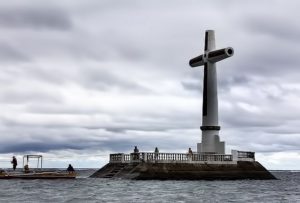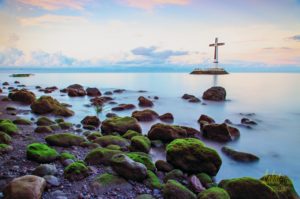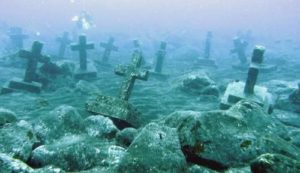A Cross Marks Location of Sunken Cemetery
Posted By philippine evolution staff on June 19, 2018
philippine-evolution.com
SUNKEN CEMETERY
 Photo from: http://geejaytravellog.blogspot.com/2014/01/sunken-cemetery-and-guiob-church-ruins-of-camiguin.html
Photo from: http://geejaytravellog.blogspot.com/2014/01/sunken-cemetery-and-guiob-church-ruins-of-camiguin.html
Located in Bonbon, Catarman a huge cross marker has been installed by the Provincial government to mark the community cemetery that sank during the 1871 volcanic holocaust. Years ago, gravestones were visible during low tide. Today, the sunken cemetery has become an interesting diving site.
As history tells about the volcanic activity from 1871 to 1875 in Catarman, on February 16, 1871, earthquakes began to be felt on the island, which increased in severity until April 30 when a volcanic fissure opened up 400 yards southwest of the village of Catarman, northwest of Hibok-Hibok Volcano. Mt. Vulcan was born and continued erupting pouring lava into the sea at the same time gaining in height and width. In 1875, the Challenger expedition visited the area and described the mountain as a dome, 1,950 ft (590 m) in height, without any crater, but still smoking and incandescent at the top.
The town of Catarman was destroyed and a portion of the town sank beneath the sea. The settlement moved to where the town center is presently located and today, all that remains of old Catarman are the ruins of the ancient Spanish church, a convent, and a bell tower. Read More: http://www.mindanaotours.com/cross-marker-and-sunken-cemetery-camiguin/
 Photo from: http://www.amusingplanet.com/2014/04/the-sunken-cemetery-of-camiguin-island.html
Photo from: http://www.amusingplanet.com/2014/04/the-sunken-cemetery-of-camiguin-island.html
There are no flowers or gravestones to mark the resting places of the lost citizens of Camiguin – only a giant cross rising up out of the water to mark where this place of rest once was.
In the 1870s, a volcano near this place erupted and caused the cemetery along with the capital city surrounding it to sink below sea level. In order to commemorate this place of loss, a looming cross was built in remembrance. Visitors all over the Philippines and the world come to admire this man-made marvel filled with legend and enchantment.
Some say a feeling of loneliness will hit you once you see this structure standing all alone in the middle of the sea. A place of reverence and reflection, the site is accessible by boat and visitors can stand on its small base while it remains above water. Many take the small boat ride in order to take photos and soak in the view of Mt. Vulcan, the volcano that sacrificed the people of Camiguin to the sea when it came into being. Read More: https://www.atlasobscura.com/places/sunken-cemetery
 Photo from: http://lakat-travel.blogspot.com/2012/12/camiguin-sunken-cemetery.html
Photo from: http://lakat-travel.blogspot.com/2012/12/camiguin-sunken-cemetery.html
Camiguin is an island province of the Philippines located in the Bohol Sea, about 10 kilometers off the northern coast of Mindanao. The island of Camiguin is of volcanic origin and composed of four young stratovolcanoes overlying older volcanic structures. These include Mt. Vulcan and Mount Hibok-Hibok, still considered active having last erupted in 1953.
During the volcanic eruption of Mt. Vulcan that lasted from 1871 to about 1875, after continuously spewing out lava into the sea, it gained a height of nearly 2,000 feet and submerged areas of Catarman, including the town’s cemetery. Today, all that remains of old Catarman are the ruins of an ancient Spanish San Roque church, a convent and a bell tower. Remnants of the structures and gravestones of the cemetery were still seen during low tide until 1948 when Mount Vulcan erupted for the fourth time, which buried the area deeper by 20 feet. In 1982, a large cross was built on the solidified lava to mark this old gravesite. Read More: http://www.amusingplanet.com/2014/04/the-sunken-cemetery-of-camiguin-island.html
 Photo from: https://www.atlasobscura.com/places/sunken-cemetery
Photo from: https://www.atlasobscura.com/places/sunken-cemetery
Watch the Videos:

Comments